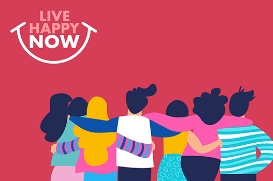3 time-tested tools for finding positivity.
Finding ways to curb our negative thoughts can allow more positivity in our lives. Just like dark clouds that can pass and let the sun shine through, happiness has a better chance of reaching us if the dark skies of negativity and depression have lifted.
Not being depressed isn’t the same as being happy. At its core, transitioning into a more sustainable state of wellbeing involves a shift in our thoughts and feelings: fewer negative thoughts and more positive ones.
Research has shown some interventions can help create greater resilience to negative states, while others can be used to enhance positivity. Some of the more intriguing options for reducing negativity are vitamin D and exercise—and one of the most effective ways to brighten your life is gratitude.
Let the sun shine in
More than a billion people are vitamin D deficient. (That’s billion with a “B.”) Research shows there is a link between low levels of vitamin D and the symptoms of depression. However, the jury is still out as to whether or not low levels of vitamin D cause depression, or the other way around. Either way the chances are good you may not be getting enough of it.
Vitamin D is unique because it is a prohormone, a substance that can be converted into a hormone. It does not have to be attained through food; it can be synthesized when the skin is exposed to ultraviolet radiation found in natural sunlight. Vitamin D then goes to the liver and kidneys where it is converted into a hormone. We can get it through sunlight, take it as a supplement, or find it in foods such as salmon, cod liver oil, milk or tuna. The trick is getting an adequate amount.
Lack of vitamin D during winter months has been linked to Seasonal Affective Disorder (SAD). Vitamin D is helpful for many things, not the least of which in the absorption of calcium and phosphorous through the intestines (which is one reason it is used as an additional supplement with calcium). Some studies have found that increasing vitamin D can improve well-being, and others suggest it may be helpful along with an antidepressant.
Ask your physician to test your vitamin D level. If it is low, ask about a supplement. Also, during the winter be sure to get a little more sunlight in your life.
Born to run
 You would have to have lived under a rock for the past 10 years not to have heard that exercise is good for you. However, what does exercise have to do with our mood?
You would have to have lived under a rock for the past 10 years not to have heard that exercise is good for you. However, what does exercise have to do with our mood?
Exercise boosts a protein known as BDNF (brain developed neurotropic factor), which is the protein that helps neurotransmitters function more efficiently. Those neurotransmitters are the very ones targeted by antidepressants, which cause unwanted side effects. This makes exercise the most natural way of enhancing this protein.
Dr. John Ratey, associate clinical professor of psychiatry at Harvard Medical School, describes BDNF as “Miracle-Gro for the brain.” Exercise is so effective the American Psychiatric Association has declared it both a stand-alone and an augmentation therapy for depression. Even moderate levels of exercise can be helpful because it enhances the effectiveness of neurotransmitters in your brain.
How much exercise you need depends on your age and physical condition. Check with your healthcare professional to see what is recommended and start slowly. It is the regularity, not the intensity, which will help.
Count on gratitude
Last, but certainly not least, are ways of directly increasing positive thoughts. The list of these interventions is growing, but few researchers would disagree that gratitude is one of the most powerful. In fact, the lead researcher on gratitude, Robert Emmons, Ph.D., calls it “queen of the virtues.”
While the notion of “counting your blessings” has been around for centuries, there are now some proven techniques that help to shift our perspective. How we feel is determined by how we see the world. One of the most effective ways of restructuring our view is by
reviewing our gratitude. A review of the last 24 hours of those specific events you have gratitude for has the power to reappraise memory by focusing on the positives.
Gratitude, in this way, has the power to transform our perception authentically. We are highlighting real events in a way that casts our memory in a different light. As an example, yesterday may not have been a particularly good day, but when seeing it through the prism of gratefulness you are likely to find occurrences overshadowed by the day’s struggles.
A friend’s email, refund check or thank you note received add up when acknowledged. Not only does our memory of the day shift toward something more encouraging, it also improves our attitude in the moment and offers a more optimistic outlook. How often should you do it? The research is mixed, but a sure bet is to start with once a week.
Dan Tomasulo holds a Ph.D. in psychology, an MFA in writing and graduated from the Master of Applied Positive Psychology (MAPP) program at the University of Pennsylvania (UPenn) in 2012. He teaches at New Jersey City University and is an assistant instructor for Martin Seligman, Ph.D., at UPenn in the MAPP program. Visit Dare2BeHappy.com.
(Visited 1 times, 1 visits today)
 You would have to have lived under a rock for the past 10 years not to have heard that exercise is good for you. However, what does exercise have to do with our mood?
You would have to have lived under a rock for the past 10 years not to have heard that exercise is good for you. However, what does exercise have to do with our mood?














